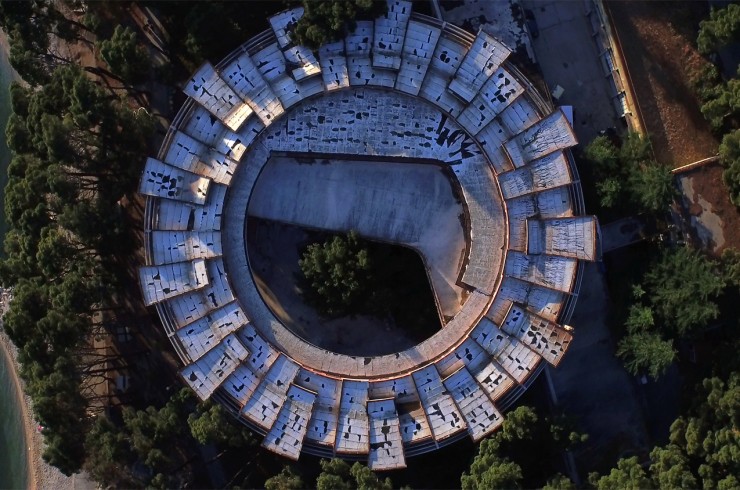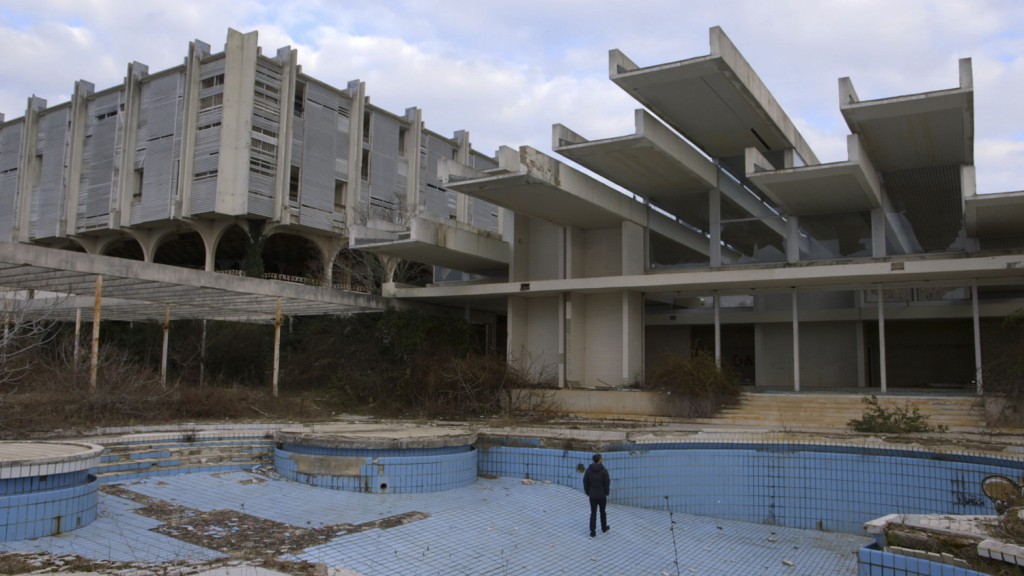Film
Documentary Film Television Series, Slumbering Concrete
The new television series of short documentary films directed by Saša Ban explores abandoned modernist architecture complexes in Croatia and along the ex-Yugoslav coast. Each episode takes us through the history of specific examples of great modernist architecture from the 20th century that now remain empty in a state of decay. We spoke with one of the screenwriters and narrator of the episode, Maroje Mrduljaš, an architectural critic who has been researching the history of modern architecture in the region for years.
The film tells the story about the culture surrounding the modern architecture in four episodes. The first focuses on touristic architecture, which was created with very specific socialist ideologies. The abandoned hotel resort, Haludovo Palace Hotel on the island of Krk is the central focus of the first episode, Socialism Meets Capitalism. The mile long complex is an outstanding example of modernist architecture that was once thriving with tourism during Socialism. The film explores the history surrounding the architecture along with personal interviews of people whose lives were directly affected by it. The unfortunate fate of recent history has left these beautiful examples of significant architecture in ruins.
What were some of the criteria for the film in order to tell the history of the Haludovo Palace Hotel?
Maroje: From the very beginning it was clear that we weren’t going to make movies only about architecture. It’s much more interesting when you introduce the people who used to work there, live there, and use the hotel. It’s impossible to re-enact the history of architecture without introducing real people who were directly attached to the building. The essential idea was to depict the specific destiny of the architecture and how it performed as part of society.
What were some of the Socialist ideas that were reflected in the architecture of touristic buildings like the Haludovo Palace?
Maroje: Architecture plays such an important role in understanding how society functioned in our recent history. During Socialism, tourist complexes were not closed resorts. There were no fences, unlike today. It’s a strong political message that a hotel, something that primarily acts as a money machine is open towards everyone and also serves the local society and community.
In ex-Yugoslavia, architects had an enormous amount of creative freedom. Architecture built for tourism was experimental, modern and developed it’s own language. Architecture was a device for the socialist view of a complete transformation of society towards a better future. Luckily, architects were left to their own devices to envision this society. A strong humanistic vision of the future was an ideological basis at the time. More advanced spatial frameworks were invented to provide citizens with a modern environment and modern facilities to better develop themselves as human beings.
Did Capitalism affect the Socialist framework of the Haludovo Palace Hotel, which was meant to be open for everybody to use?
Maroje: It created a more complex and diverse social environment. There were political leaders, American gamblers, tourists and locals all in the same complex. When Bob Guccione, the founder of Penthouse Magazine came in 1972, he saw the interesting architecture as a place where he could test his vision of a casino in Yugoslavia. He used the Cold War story to boost his project, which was only possible in Yugoslavia, because it was geopolitically situated between Western and Eastern countries. Guccione’s clever marketing / PR agenda created a reconciliation between Socialism and Capitalism. For example, he called his pet-girls “little soldiers of freedom”. This strange assemblage of hedonism and challenging Cold War divisions fitted in the framework of Yugoslav socialism and created something new and interesting within the architecture that was created prior to when Guccione’s business ideas came into place there.
How does the film portray the effects of the downfall of the Haludovo Palace Hotel?
Maroje: It’s almost impossible to reconstruct how the privatization process and decline in Haludovo actually went. Many issues are hidden from the public and even consulting all legal documents wouldn’t tell the story. But that’s not really needed; the actual effect of privatization appears from the stories of people who used the building. It was especially touching to hear from a musician who used to play music at the Haludovo Palace Hotel. His whole life was embedded in the terrace of the building and it all disappears in front of his eyes. Part of the reason that these buildings are neglected now is because of the values that we inherited but didn’t manage to preserve and bring forward in contemporary society.
By depicting these architectural ruins and personal stories surrounding them, what is the message that the viewer takes away from watching the TV series?
Maroje: There is definitely a political message in our work, although we are not screaming it. The message is obvious once you present all the advantages and qualities of this architecture and the social context that was able to produce it. We try to emphasize the cultural, social and economic aspects of socialism that were successful at the time. We don’t explicitly advocate socialism itself, but it’s quite clear from the narrative of the films that these values are important and could still be utilized in some way.
Parts of the film were shot with drones that allowed the viewer to feel like they were interacting a lot with the space. How did you decide to film certain parts of the architecture?
Maroje: One never experiences architecture as a static object, so we decided to use a lot of moving cameras. The experience of architecture is always through movements and bodies in space. The beginning idea was to try to film as if we were discovering the space along with the viewer. Since these architectures are abandoned and their boundaries are destroyed, we had a chance to experiment with interesting lines of movement from exterior to interior, and through the interior. The collaboration between the film director, director of photography and myself was very synergic. All of the decisions were really collective with everybody involved. I was really happy with the entire process. My whole career is about mediating architecture, whether through text, printed images in books and magazines or architectural models at exhibitions. Film was a great discovery for me, I felt emancipated from constrains I’ve faced in my previous work.
What were some of the reactions from the international viewers?
Maroje: People reacted very positively and showed a lot of interest in the film so far. When you tell the story through the medium of film, it includes personal stories along with striking visuals. Everything is in one place and communicated in an efficient medium. This makes it more accessible for a wider audience, not just experts on the subject. We’ve already received invitations for small film festivals in Finland and Switzerland that specialize in architecture, so I’m looking forward to when we can finally present the full series.
The series has three other chapters. Besides the first dedicated to tourism, the second is to monuments and commemorative buildings, third to post-industrial and post-military landscapes and the fourth to unfinished modernizations. Will the entire series also be available to an international market?
Maroje: One of the possibilities we are also thinking about is compiling the four episodes into one movie that could be shown at different film festivals. It’s not going to be an easy task, but we are searching for appropriate funds and partners.
Slumbering Concrete acts as a reminder of the recent history of the region and the effects that the new political system in 1991 had on the economical, social and urban landscape in the area. Witnessing these ruins is melancholic, but at the same time extremely impressive. Unfortunately, the best architecture of this time period is disappearing, so it’s essential to let their legacy live on through the series.
Director: Saša Ban
Screenwriters: Nevenka Sablić, Saša Ban, Maroje Mrduljaš
Narrator: Maroje Mrduljaš
DOP: Hrvoje Franjić
Editing: Vanja Siruček
Producers: Miljenka Čogelja and Dana Budisavljević
Production: Hulahop for HRT
Editor: Robert Zuber
Interview by Kelly Foster









